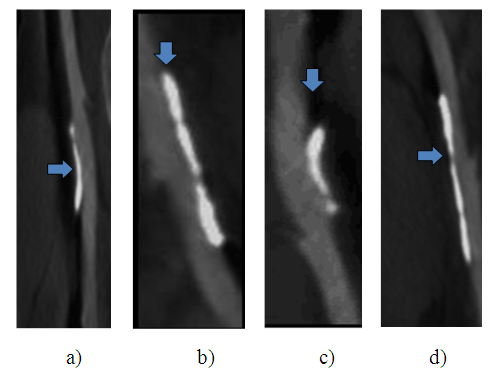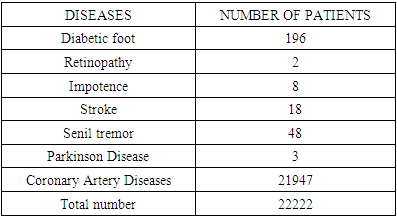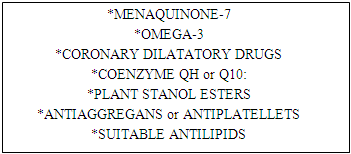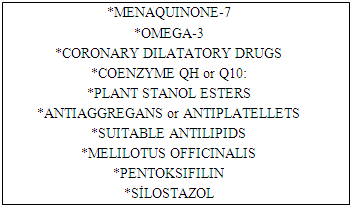-
Paper Information
- Next Paper
- Paper Submission
-
Journal Information
- About This Journal
- Editorial Board
- Current Issue
- Archive
- Author Guidelines
- Contact Us
American Journal of Medicine and Medical Sciences
p-ISSN: 2165-901X e-ISSN: 2165-9036
2020; 10(1): 38-43
doi:10.5923/j.ajmms.20201001.09

This is a Revolution= An Innovative Medical Treatment (Erzengin’s Solutions) for Arteriosclerosis Obliterans
Faruk Erzengin1, Evren Burşuk2, Esra Erzengin3, Ömer Mehmet Erzengin4, Memduh Dursun5, Kasım Cemal Güven6
1Department of Cardiology, Previous Dean, Istanbul Medical Faculty, University of Istanbul, Istanbul, Turkey
2Program of Biomedical Technologies, Vocational School of Technical Sciences, University of Istanbul Cerrahpasha, Istanbul, Turkey
3Department of Business (Statistical), Faculty of Economics and Administrative Sciences, University of Beykent, Istanbul, Turkey
4Department of Gynecology, Veterinary Faculty, University of Istanbul, Istanbul, Turkey
5Department of Radiology, Istanbul Medical Faculty, University of Istanbul, Istanbul, Turkey
6Department of Pharmaceutical Technology, Previous Dean, Faculty of Pharmacy, University of Istanbul, Istanbul, Turkey
Correspondence to: Faruk Erzengin, Department of Cardiology, Previous Dean, Istanbul Medical Faculty, University of Istanbul, Istanbul, Turkey.
| Email: |  |
Copyright © 2020 The Author(s). Published by Scientific & Academic Publishing.
This work is licensed under the Creative Commons Attribution International License (CC BY).
http://creativecommons.org/licenses/by/4.0/

Now after that, atherosclerosis can be treated completely by our spectacular solutions . This is a great invention in medicine. Our solutions; one of which is Erzengin’s solution I (ES-I) effects on all atherosclerosis obliterans by only medically, such as coronary atherosclerosis and peripherial atherosclerotic disease. The other solution complexes (Erzengin’s solution II and III are also effective in Diabetic and atherosclerotic arterial foot diseases, Parkinsonizm and essential tremor, stroke, diabetic retinopathy, and impotence, such as arterioles-venules-capillary level diseases acutely. We strongly proved that these solutions will be breakthrough in medicine. It was also observed that our innovative combined drugs (Erzengin’s solutions) are able to prevent the formation of atherosclerotic and calcified plaque of arteries, and to regress pre-existing ones (Chronical treatment). We have completely treated 22222 cases totally by Erzengin’s solution I (21947 patients), and Erzengin’s solutions II and III (275 patients), successfully.
Keywords: Innovative medical treatment for coronary atherosclerosis, Erzengin’s solutions (ES-1, II, III), Current medical treatment for coronary atherosclerosis
Cite this paper: Faruk Erzengin, Evren Burşuk, Esra Erzengin, Ömer Mehmet Erzengin, Memduh Dursun, Kasım Cemal Güven, This is a Revolution= An Innovative Medical Treatment (Erzengin’s Solutions) for Arteriosclerosis Obliterans, American Journal of Medicine and Medical Sciences, Vol. 10 No. 1, 2020, pp. 38-43. doi: 10.5923/j.ajmms.20201001.09.
1. Introduction
- Atherosclerosis is a most common life-threatening process. The term atherosclerosis refers to the thickened and hardened lesions, which have lipids and calcifications in the intimae and media of elastic and muscular arteries. Today, it is known that atherosclerosis begins as early as fetal life, especially in the fetuses of hypercholesterolemic parents [1]. Formation and progression of atherosclerotic plaques and calcifications in all arterial beds of intimae have been well documented by many authors, such as Fuster and Falk [1-3], who subdivided the formation and progression of these plaques into several phases (Figure 1).
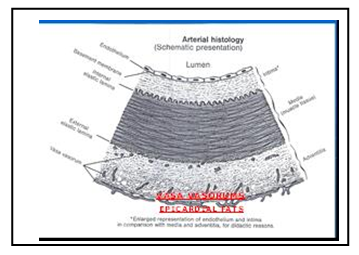 | Figure 1. This figure shows arterial structures such as epicardial fats tissue, vasa vasorums and tunicas of an artery |
2. Material and Methods
- Before the date of 7.7.97, the ethics committee approval was obtained from the ethics committee of Istanbul University and then this study was started. Before clinical studies, randomized double blind placebo controlled experimental animals (preclinical studies) were studied and the results were statistically significant. We examined coronary atherosclerotic calcifications and modern current treatment in 22222 patients at Istanbul Medical Faculty by using randomized double-blind controlled placebo studies, and focused in particular on adventitial localization since 07.07.1997. In this context, four different consecutive cases (Fig.4-6) were investigated by MSCT 640 and conventional coronary angiography. In comparison with IVUS, Stephan Achenbach et al found a sensitivity of 82% to detect coronary artery segments containing atherosclerotic plaque in patients without significant coronary artery stenosis [4]. MSCT might be useful for the characterization of human coronary plaque morphology by non-invasively determining tissue density within the lesion [9-12]. On Figure 2, the adventitial atherosclerotic calcifications (atheromatous components) on the femoral arteries of Guinea pig, rabbit, goat and mouse have been shown.
 | Figure 3. Adventitial soft plaque on the right coronary artery of a 48 years old man (is shown white arrow) |
 | Figure 4. Multi-size adventitial atherosclerocalcifications on the LAD and Cx arteries |
|
|
3. Results and Discussion
- However, our team recently demonstrated the adventitial localization of atherosclerotic calcifications by using the 640 Multi Slice Computed Tomography (MSCT) with a magnifying glass on 22222 atherosclerotic patients and 275 arterioles-venules level patients. As a result of our studies, these views were generated step-by-step as our knowledge has increased and become more refined since 1997. We strongly emphasize that most of the patients have a coronary spasm (mostly diffuse) during invasive coronary angios [4]. Due to the stressful conditions of invasive coronary angiography, it is important to emphasize that most of the cases involve local (especially areas with atheromatous plaque such as the right coronary artery orifice) or systemic coronary artery catheter contact with prolonged spasms and that these patients are exposed to unnecessary CABG operation. It is very important to keep this point in mind, because of the fact that at the beginning of the invasive angios should be given GTN (Nitroglyserin) sublingually. MSCT (especially the 640 section) is applied in physiological conditions, eliminating these errors and avoiding unnecessary coronary surgical interventions.Atherosclerotic calcification is one of the major causes of progressive degradation of the human arteries and target organs. It progresses insidiously and its damaging effects of human organism remain unknown for a long time before cardiac, cerebral or peripheral symptoms and/or other ischemia develop. For many years, atherosclerotic plaque formation has been accepted as a dynamic, progressive process and a very dangerous, fatal disease which can never be effectively prevented, stabilized or treated because of its dangerous progression. According to our new clinical and laboratory findings; we believe that atherosclerotic and calcified plaques can be stabilized and fully treated with only drug therapy, regardless of where their localization is on the arteries. This means that, in addition to the current treatment, our ES-I can totally cure the atherosclerosis and prevent plaque formation permanently. So, we have proved that this insidious and potentially fatal process is regressive, preventable and totally curable using only a combined drug therapy. Erzengin’s solution (I-III) is a spectacular herbal complex solution strongly effects immediately within two-four hours on above the mentioned group helpless diseases particularly arterioles-venules-capillary level. Nowadays, preliminary studies are ongoing for this herbal solution. In this context, we will write about a new additional treatment combinations (Erzengin’s solutions I-III) for atherosclerotic plaques. Here, we will present Erzengin’s new medical combination therapy against this progressive, dynamic and potentially fatal disease. Dosages of this treatment combinations (ES I-III) vary from patient to patient. As you know, each patient is an antitemorbid. Because of the fact that, at the beginning of this outstanding treatment we have found; according to the patients' symptoms and signs and advanced laboratory findings, it is decided which one the treatment combinations should be used. Atherosclerotic calcifications lead to death and disability by occluding the arteries of vital organs. The non-invasive treatment prevents this severe diseases, which otherwise require expensive, often palliative and high-risk surgical procedures and/or invasive interventions. The medical treatment would also be necessary after CABG surgery or stent implantation in order to prevent the progression of the virulent process. Erzengin’s combination therapy also makes a major contribution to the treatment of osteoporosis while it prevents diseases such as atherosclerotic calcified arteries. We found that the side effect of this drug was headache Fortunately, it was unimportant because we observed less than 2.3% patients. Any bleeding and obstruction was not seen any of the patients. The main purpose of our therapy with Erzengin’s Solution I (ES-I) is to prevent the formation of atherosclerosis, eliminate the existing atherosclerosis, and to completely heal the existing disease [17-18].In the light of recent developments and new knowledge, suitable anti-lipid and anti-thrombotic treatments are approved for suitable patients. In addition to these treatments, it is known that Menaquinone-7 (Vitamin K2, found in Soybeans and green lentils) [19] and Vitamin D3 causes the arterial calcifications regress, and the calcium to mobilize from the walls of arteries to the bones. Insufficient ingestion of Vitamin K2 (Menaquinone) causes atherosclerotic and calcified plaques on the arterial walls and atherosclerotic coronary arteries due to the lack of Matrix Gla-Protein (MGP) carboxylation. This means that sufficient ingestion of Menaquinone-7 (especially Vitamin K2 = MK-7) prevents atherosclerotic and calcified plaque formation [19]. The results of Menaquinone-7 treatment are controlled by using MSCT. In addition, according to several studies, it has been observed that the ingestion of Plant Sterol Esters and particularly the esters of Plant Stanol lowers total cholesterol, LDL and triglyceride in serum and cures atherosclerosis in the ratio of 15-27%. The combination of Plant Stanol Esters and statins prevent atherosclerosis in the ratio of 46%. According to our results; Plant Stanol esters are more effective than sterols. On the other hand, these esters prevent side effects of statins. The other two components of Erzengin’s solution I combination are Omega-3 (Eicosapentaenoic Acid – EPA and Docosa-hexaenoic Acid – DHA) and Ubiquinol (Coenzyme QH) (Table 3). Contents of ES-II and ES-III solutions are also shown in Tables 4 and 5.
|
|
|
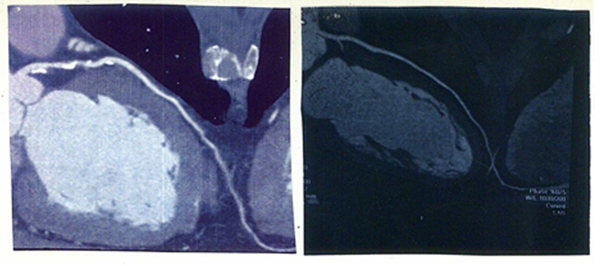 | Figure 5. Healing of atheromatous components are shown before and after treatment with solution ES-I |
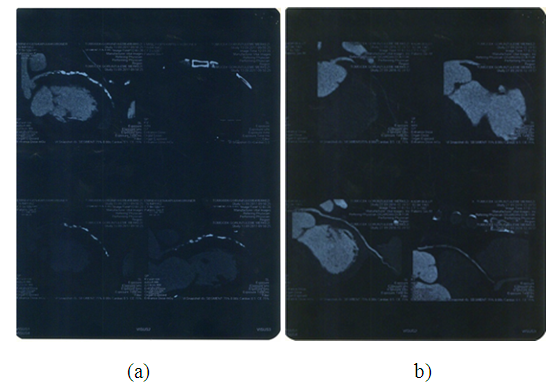 | Figure 6. Healing of atheromatous components are shown before (a) and after (b) treatment with solution ES-I |
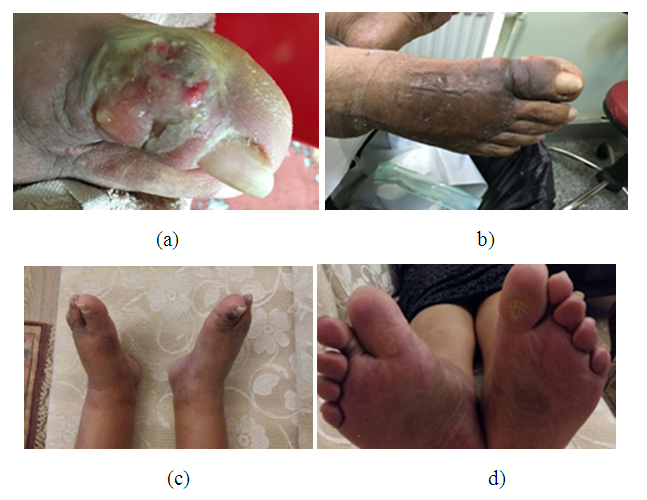 | Figure 7. Diabetic foot a) Before treatment; b) One week after treatment with solution ES-II; c) Two weeks after treatment with solution ES-II; d) One month after treatment with solution ES-II |
4. Conclusions
- We conclude that the MSCT is a very important tool for the diagnosis and evaluation of coronary lesions. In addition, it is an important guide for curing silent ischemia and myocardial infarction, particularly for patients unwilling to undergo invasive coronary angiography. Today;- It is possible to treat coronary atherosclerosis can be treated medically with only drug combination therapies.(An innovative treatment and exact solution for coronary atherosclerosis and calcifications)- Also, it is possible to treat many helpless diseases such as Parkinsonizm and essential tremor, complications of diabetes mellitus such as Diabetic foot, stroke, chronical renal parenchymal diseases and uremia, retinopathy, Alzheimer, impotence and chronical obstructive lung disease (COLD), glaucoma and cataract.- So much so that, if the studies accomplish their objectives, there will be a permanent solution for the atherosclerosis that leads to severe diseases in arteries of target organs and sudden deaths. The combination of Erzengin’s herbal complex solution (EASX) and Erzengin’s solution I together with the ordinary therapy will sort out the complications of the athero-sclerosis permanently. We strongly believe that this combined therapy will completely stop and treat the atherosclerosis in a non-invasive, risk-free and inexpensive way. Our research will make an incomparable contribution to all of humanity by expanding the life span and enhancing quality of life. It will represent a remarkable success in the name of science, and make a great contribution to the economy.
 Abstract
Abstract Reference
Reference Full-Text PDF
Full-Text PDF Full-text HTML
Full-text HTML